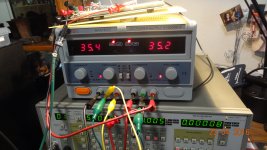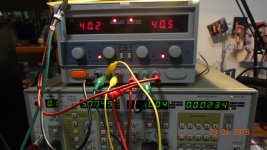Ahh, penny drops.
Yes, well maybe 🙂. Just add spare time. Which gives me another few months of angst over ported or sealed for the main enclosure 🙂
Yes, well maybe 🙂. Just add spare time. Which gives me another few months of angst over ported or sealed for the main enclosure 🙂
Don't try that with power mosfets . . . Higher voltage epi has lower resistivity so for a given Rds(on) you need a bigger die. One of the cost saving tricks is to keep the BVd breakdown spec as close to the rated epi breakdown voltage. I had a big argument with my dev crew about this - they always set the epi voltage at 20% above the spec to ensure high yields (very high nineties even for big trench mosfets). The fab liked high yields and the guys were bonused on yield performance. We ended up squeezing about 10% on cost over a two year period just by getting processes enough under control so that we could spec the breakdown to within 2-3 volts of the epi rating on a 100V mosfet. Even tighter on low voltage mosfets for the computing market. I wasn't flavour of the month for a while, but I got my way on the issue.
😎
😎
Last edited:
The 5534 runs well up to +/- 35vdc. At +/-40vdc 😱 thermal issues start to come into affect and thermal runaway begins (if not heat sinked or other conditions - loading, etc are not changed). Not going to smoke it, though. Will run well all year long at +/-24vdc.
I think that's quite remarkable, I really do.
The 5534 runs well up to +/- 35vdc. At +/-40vdc 😱 thermal issues start to come into affect and thermal runaway begins (if not heat sinked or other conditions - loading, etc are not changed). Not going to smoke it, though. Will run well all year long at +/-24vdc.
View attachment 545078
View attachment 545079
THx-RNMarsh
RNM,
Ever since IC's started to replace discrete devices in pro audio gear one issue has been headroom. 0 dBm is 1 milliwatt into 600 ohms or .7746 volts. Most VU meters show 0 at +4 dBm. Or 3.47 volts peak to peak with the desired 20 dB headroom that becomes 34.7 volts peak to peak which is really a bit difficult to swing on most opamps.
The NE5532 as the specs say typical is about two volts less than the rail voltage at 600 ohms load and 25C. Now the specs do list +/- 22 for V max. So it was designed to do this. However in some pro gear the standard became + 30 dBm output which requires 70 volts peak to peak. Apparently the 5532 can just about do this!
Now for microphone preamps in my use the input level varies just a bit between the announcer turning his head and talking around the microphone to when he gets excited scream directly into it. So I prefer my preamp and compressor rails to run at least 150 volts.
Good er GREAT work,
ES
Last edited:
To me, some of the things written here are a revelation. The worst I ever did to any op amp was to drive with maximum allowable rail voltage and pray it doesn't blow its top. Now I find people driving them at rails like 50% higher than specified and nobody seems to get smoked.
Not really unheard of, I've tested quite a few discrete transistors at voltages above their specified ratings and many a time, nothing happned, it worked on. This is especially true of Motorola/ON Semi's devices, which is why I have such a strong preference for them. I know I can really push them.
Not really unheard of, I've tested quite a few discrete transistors at voltages above their specified ratings and many a time, nothing happned, it worked on. This is especially true of Motorola/ON Semi's devices, which is why I have such a strong preference for them. I know I can really push them.
To me, some of the things written here are a revelation. The worst I ever did to any op amp was to drive with maximum allowable rail voltage and pray it doesn't blow its top. Now I find people driving them at rails like 50% higher than specified and nobody seems to get smoked.
Not really unheard of, I've tested quite a few discrete transistors at voltages above their specified ratings and many a time, nothing happned, it worked on. This is especially true of Motorola/ON Semi's devices, which is why I have such a strong preference for them. I know I can really push them.
Sure but you might be shortening the lifespan, not blowing it up. That might be inconsequential given transistors typically far out last capacitors.
Detroyer you are right, however, I am in waters with PSU lines of no greater than +/- 60V worst case, which helps me keep the availble choice range rather wide. So, in effect, most devices rated for say 150V and upwards are just fine for me, no chance of overloading voltage amps.
I know I can really push them.
This well known phenomena apparently needs to be mentioned again.
https://en.wikipedia.org/wiki/Time-dependent_gate_oxide_breakdown
The breakdown is caused by formation of a conducting path through the gate oxide to substrate due to electron tunneling current, when MOSFETs are operated close to or beyond their specified operating voltages.
Same holds true for capacitors on normal bi-polar amplifiers. Someone familiar with the concept of activation energy will understand the exponential nature of the problem, i.e. (just to make up some numbers) lifetime at 36V 100yr. at 44V 1yr. or as some have observed near the limit seconds.
My chemistry teacher had a demo (SY?) where he would mix two clear liquids together and at exactly a set time later the whole thing would instantly turn red.
Last edited:
car analogy: " redline on my tach is 7000rpm but I just pushed it to 10000 so I can cruise there"
Experimentalists can estimate the parameters of the voltage-vs-lifetime curve by making a scatter plot of lifetime vs voltage on semilog axes. Fit two curves to the data: one for the upper boundary of the cloud of scatter dots ("longest lived freak units") and another for the lower boundary ("shortest lived freak units").
Armed with these empirical equations, DIYers can now choose a (supply_voltage, lifetime) operating point as they see fit. Maybe lifetime = 8800 hours is appropriate, given that DIY equipment gets replaced relatively often. If the gear is only powered up for 6 hours per day that's 4 calendar years.
Armed with these empirical equations, DIYers can now choose a (supply_voltage, lifetime) operating point as they see fit. Maybe lifetime = 8800 hours is appropriate, given that DIY equipment gets replaced relatively often. If the gear is only powered up for 6 hours per day that's 4 calendar years.
Given that my amp is usually on for 24hours a day and that much of my equipement is over 20years old, I'd like lifetimes to exceed the 100000hrs (11.4years, or 0M1hrs=100khrs) region.
I replaced the PSU electrolytic in my Quad FM4 last year and it was probably more than 30years old.
I replaced the PSU electrolytic in my Quad FM4 last year and it was probably more than 30years old.
i.e. (just to make up some numbers) lifetime at 36V 100yr. at 44V 1yr. or as some have observed near the limit seconds.
This example equates to roughly a halving of lifetime per additional V. Is that a fair rule-of-thumb? (Like the halving of lifetime per additional 10 degrees of elco's, as I seem to remember)
I'm not a vacuum tube user so I resorted to Google to learn about vacuum tube effective lifetime in high end audio gear. Maybe Google misled me, but it appears that at least Audio Research equipment owners feel the tubes start to audibly degrade after 2000-3000 hours of use. The tubes aren't "dead", but their parameters have shifted and this is audibly worse. AR keeps a large stock of brand new tubes for all their old equipment, and they do a brisk business in selling complete retube kits link 1 and third party companies sell AR retube kits for considerably less money link 2.
Perhaps that's a lifetime specification to aim for: Run your NE5532s at just high enough power supply voltage, to give a lifetime equal to the lifetime of high end vacuum tubes: 2500 hours.
Perhaps that's a lifetime specification to aim for: Run your NE5532s at just high enough power supply voltage, to give a lifetime equal to the lifetime of high end vacuum tubes: 2500 hours.
This example equates to roughly a halving of lifetime per additional V. Is that a fair rule-of-thumb?
No it isnt.
-RNM
Experimentalists can estimate the parameters of the voltage-vs-lifetime curve by making a scatter plot of lifetime vs voltage on semilog axes. Fit two curves to the data: one for the upper boundary of the cloud of scatter dots ("longest lived freak units") and another for the lower boundary ("shortest lived freak units").
Armed with these empirical equations, DIYers can now choose a (supply_voltage, lifetime) operating point as they see fit. Maybe lifetime = 8800 hours is appropriate, given that DIY equipment gets replaced relatively often. If the gear is only powered up for 6 hours per day that's 4 calendar years.
This seems like a good approach. But I am not going to do it.... way too long and too many bought devices. It would be great if the mfr made that kind of data available. I dont need opamps to last 100+ years as they seem to. Deep mission space probes, maybe. I/we should check further into characteristic changes, if any.
It does seem that at +/- 24vdc most opamps will outlast my remaining life time.
THx-RNMarsh
Last edited:
Given that my amp is usually on for 24hours a day and that much of my equipement is over 20years old, I'd like lifetimes to exceed the 100000hrs (11.4years, or 0M1hrs=100khrs) region.
I replaced the PSU electrolytic in my Quad FM4 last year and it was probably more than 30years old.
Yet if you recapped them you'd probably have a better sounding stereo. All out failure doesn't seem so common anymore.
It does seem that at +/- 24vdc most opamps will outlast my remaining life time.
THx-RNMarsh
Pessimist! 🙂
I/we should check further into characteristic changes, if any. [quote
------------------------------------------------------------------------------
I did monitor the dc output offset voltage as well as thd. No changes seen in offset until everything goes nuts (technical term). I suspect that is because of the large amount of CCS etc used within.
THx-RNMarsh
Last edited:
- Status
- Not open for further replies.
- Home
- Member Areas
- The Lounge
- John Curl's Blowtorch preamplifier part II

